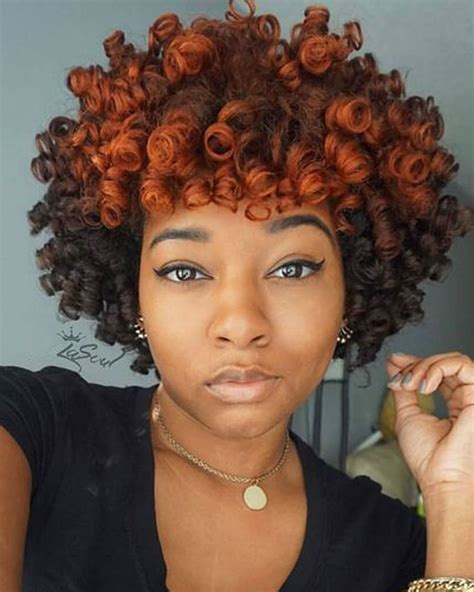Black women have embraced the beauty of their natural hair for centuries. From intricate braids and locs to voluminous afros and sleek bobs, the possibilities for styling are endless. But for those looking to add a pop of color or make a statement, hair dye can be a transformative tool.

- Express individualism: Hair color offers a unique way to express oneself and showcase creativity.
- Celebrate heritage: Certain hair colors, such as the vibrant reds and oranges found in traditional African hairstyles, can pay homage to cultural roots.
- Enhance skin tone: The right hair color can complement and enhance the wearer’s skin tone, making them appear more radiant and youthful.
1. Midnight Black: Deepen the natural richness of your hair with a midnight black shade, adding depth and elegance to any hairstyle.
2. Chocolate Brown: Warm up your tresses with a chocolate brown hue, creating a versatile and universally flattering look.
3. Caramel Highlights: Add a touch of warmth and dimension to dark hair by incorporating subtle caramel highlights that mimic the natural sun-kissed effect.
4. Copper Red: Embrace a fiery spirit with a bold copper red shade, perfect for showcasing dramatic styles such as bobs and short cuts.
5. Mahogany: Create a sophisticated and alluring look with a rich mahogany hue, which adds depth and warmth to any hair texture.
6. Auburn: A blend of red and brown, auburn is a striking and vibrant color that complements warm skin tones and medium to long hair lengths.
7. Wine Red: Turn heads with a sultry wine red shade, perfect for adding a touch of mystery and drama to your ensemble.
8. Honey Blonde: Lighten up your hair with a warm honey blonde shade, creating a sun-kissed glow that flatters all skin tones.
9. Platinum Blonde: For a bold and edgy look, consider a platinum blonde shade, which can transform any hairstyle into a statement piece.
10. Ombre Balayage: Combine two or more hair colors to create a gradual transition, adding depth and dimension to your hair while minimizing damage.
11. Blue Ombre: Embrace your inner mermaid with a blue ombre technique, starting with dark roots and transitioning to a vibrant blue hue at the ends.
- Hair damage: Chemical hair treatments can damage hair, especially if done incorrectly. Always consult a professional hairstylist and follow their instructions carefully.
- Color fading: Hair color can fade over time, especially if exposed to sunlight or harsh chemicals. Use color-protecting shampoos and conditioners to maintain vibrancy.
- Root touch-ups: As your natural hair grows out, the roots will reveal your original hair color. Schedule regular touch-ups with your hairstylist to maintain a consistent appearance.
1. Consult a hairstylist: Schedule a consultation with an experienced hairstylist to discuss your hair color goals and determine the best approach for your hair type and texture.
2. Choose your color: Select a hair color that complements your skin tone and personal style. Consider the undertones of your skin and your natural hair color to ensure a harmonious result.
3. Apply the dye: Your hairstylist will apply the hair dye according to the manufacturer’s instructions. This typically involves dividing the hair into sections and applying the dye evenly.
4. Rinse and condition: Once the processing time is complete, rinse the hair thoroughly and apply a conditioning treatment to nourish and protect the hair.
5. Style and maintain: Style your hair as desired and follow the hairstylist’s recommendations for maintaining the color’s vibrancy.
Pros:
- Express individuality and enhance style
- Highlight facial features and complement skin tone
- Create a variety of looks and textures
- Conceal gray hairs and rejuvenate the appearance
Cons:
- Can damage hair if done incorrectly
- Regular touch-ups may be necessary to maintain color
- Color can fade over time, especially with exposure to sunlight
- Some hair colors may require bleaching or other chemical treatments
| Year | Popular Color | Style |
|---|---|---|
| 2022 | Mahogany | Textured bobs |
| 2023 | Copper Red | Loose waves and curls |
| 2024 | Honey Blonde | Shaggy layers |
| 2025 | Platinum Blonde | Sleek ponytails |
| Skin Tone | Complementary Hair Colors |
|---|---|
| Dark | Midnight Black, Chocolate Brown, Copper Red |
| Medium | Mahogany, Auburn, Wine Red |
| Light | Caramel Highlights, Honey Blonde, Platinum Blonde |
| Pain Point | Solution |
|---|---|
| Hair damage | Consult a professional hairstylist, use color-protecting products |
| Color fading | Use color-protecting shampoos and conditioners, avoid exposure to sunlight |
| Root touch-ups | Schedule regular touch-ups with hairstylist, use root touch-up products |
| Step | Description |
|---|---|
| 1 | Consult a hairstylist |
| 2 | Choose your color |
| 3 | Apply the dye |
| 4 | Rinse and condition |
| 5 | Style and maintain |
Q: Can I color my own hair at home?
A: While it is possible to color your own hair at home, it is generally recommended to seek professional help to ensure a successful and safe result.
Q: How often should I touch up my hair color?
A: The frequency of touch-ups depends on the color chosen and the rate of hair growth. As a general rule, touch-ups are recommended every 4-8 weeks.
Q: Can hair coloring damage my hair?
A: Yes, chemical hair treatments can damage hair, especially if done incorrectly. It is important to follow the instructions carefully and consult a professional if needed.
